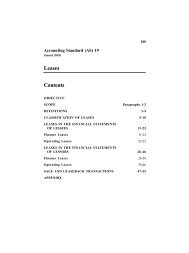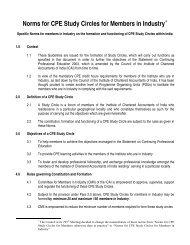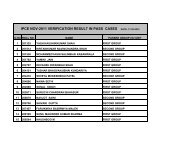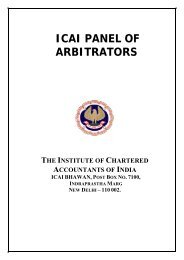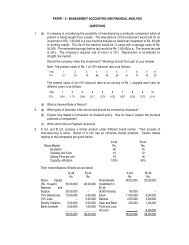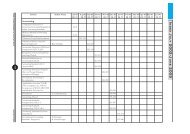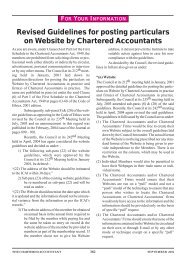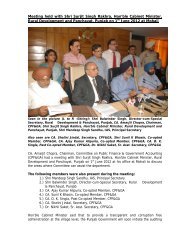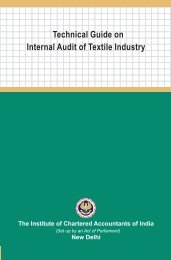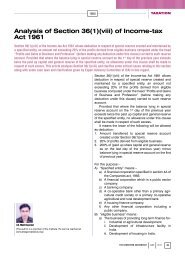The Chartered Accountant
The Chartered Accountant
The Chartered Accountant
You also want an ePaper? Increase the reach of your titles
YUMPU automatically turns print PDFs into web optimized ePapers that Google loves.
Legal or Regulatory Restrictions<br />
on Communicating with Those<br />
Charged with Governance<br />
A4. Laws or regulations may restrict<br />
the auditor’s communication of certain<br />
matters with those charged with<br />
governance. For example, laws or<br />
regulations may specifically prohibit a<br />
communication, or other action, that<br />
might prejudice an investigation by an<br />
appropriate authority into an actual, or<br />
suspected, illegal act. In some circumstances,<br />
potential conflicts between<br />
the auditor’s obligations of confidentiality<br />
and obligations to communicate<br />
may be complex. In such cases, the<br />
auditor may consider obtaining legal<br />
advice.<br />
Those Charged with Governance<br />
(Ref: Para. 7)<br />
A5. Governance structures may<br />
vary reflecting different size and ownership<br />
characteristics. For example:<br />
l In most of the entities, those<br />
charged with governance hold<br />
positions that are an integral<br />
part of the entity’s legal structure,<br />
for example, company directors.<br />
In others, for example,<br />
some government undertakings<br />
a body that is not part of the<br />
entity is charged with governance.<br />
l In some cases, some or all of<br />
those charged with governance<br />
are involved in managing the<br />
entity. In others, those charged<br />
with governance and management<br />
comprise different persons.<br />
A6. In most entities, governance is<br />
the collective responsibility of a governing<br />
body, such as a board of directors,<br />
a supervisory board, partners,<br />
proprietors, a committee of management,<br />
a council of governors, trustees,<br />
or equivalent persons. In some<br />
smaller entities, however, one person<br />
may be charged with governance, for<br />
example, the owner-manager where<br />
there are no other owners, or a sole<br />
trustee. When governance is a collective<br />
responsibility, a subgroup such as<br />
DECEMBER 2008 1094 THE CHARTERED ACCOUNTANT<br />
STANDARDS<br />
an audit committee or even an individual,<br />
may be charged with specific<br />
tasks to assist the governing body in<br />
meeting its responsibilities. Alternatively,<br />
a subgroup or individual may<br />
have specific, legally identified responsibilities<br />
that differ from those of the<br />
governing body.<br />
A7. Such diversity means that it is<br />
not possible for this SA to specify for<br />
all audits the person(s) with whom<br />
the auditor is to communicate particular<br />
matters. Also, in some cases<br />
the appropriate person(s) with whom<br />
to communicate may not be clearly<br />
identifiable from the applicable legal<br />
framework or other engagement<br />
circumstances, for example, entities<br />
where the governance structure is not<br />
formally defined, such as some family-owned<br />
entities, some not-for-profit<br />
organisations, and some government<br />
entities. In such cases, the auditor may<br />
need to discuss and agree with the<br />
engaging party the relevant person(s)<br />
with whom to communicate. In deciding<br />
with whom to communicate, the<br />
auditor’s understanding of an entity’s<br />
governance structure and processes<br />
obtained in accordance with SA 315<br />
is relevant. <strong>The</strong> appropriate person(s)<br />
with whom to communicate may vary<br />
depending on the matter to be communicated.<br />
A8. Proposed Revised SA 600, “Special<br />
Considerations- Audits of Group<br />
Financial Statements (Including the<br />
Work of Component Auditors) 9 ”, includes<br />
specific matters to be communicated<br />
by group auditors with those<br />
charged with governance. When the<br />
entity is a component of a group, the<br />
appropriate person(s) with whom the<br />
component auditor communicates<br />
depends on the engagement circumstances<br />
and the matter to be communicated.<br />
In some cases, a number<br />
of components may be conducting<br />
the same businesses within the same<br />
system of internal control and using<br />
the same accounting practices. Where<br />
those charged with governance of<br />
those components are the same (e.g.,<br />
common board of directors), duplica-<br />
9 <strong>The</strong> Exposure Draft of Revised SA 600, has been published in the June, 2008 issue of the Journal.<br />
tion may be avoided by dealing with<br />
these components concurrently for<br />
the purpose of communication.<br />
Communication with a Subgroup<br />
of Those Charged with Governance<br />
(Ref: Para. 8)<br />
A9. When considering communicating<br />
with a subgroup of those charged<br />
with governance, the auditor may take<br />
into account such matters as:<br />
l <strong>The</strong> respective responsibilities<br />
of the subgroup and the governing<br />
body.<br />
l <strong>The</strong> nature of the matter to be<br />
communicated.<br />
l Relevant legal or regulatory requirements.<br />
l Whether the subgroup has the<br />
authority to take action in relation<br />
to the information communicated,<br />
and can provide further<br />
information and explanations<br />
the auditor may need.<br />
A10. When deciding whether there is<br />
also a need to communicate information,<br />
in full or in summary form, with<br />
the governing body, the auditor may<br />
be influenced by the auditor’s assessment<br />
of how effectively and appropriately<br />
the subgroup communicates relevant<br />
information with the governing<br />
body. <strong>The</strong> auditor may make explicit<br />
in agreeing the terms of engagement<br />
that, unless prevented by laws or regulations,<br />
the auditor retains the right to<br />
communicate directly with the governing<br />
body.<br />
A11. Audit committees (or similar<br />
subgroups with different names) exist<br />
in many jurisdictions. Although their<br />
specific authority and functions may<br />
differ, communication with the audit<br />
committee, where one exists, has become<br />
a key element in the auditor’s<br />
communication with those charged<br />
with governance. Good governance<br />
principles suggest that:<br />
l <strong>The</strong> auditor will be invited to<br />
regularly attend meetings of the<br />
audit committee.<br />
l <strong>The</strong> chair of the audit com-



